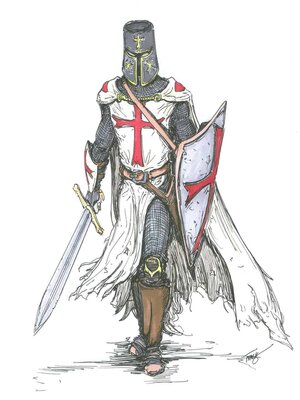
Sign up to save your library
With an OverDrive account, you can save your favorite libraries for at-a-glance information about availability. Find out more about OverDrive accounts.
Find this title in Libby, the library reading app by OverDrive.



Search for a digital library with this title
Title found at these libraries:
| Library Name | Distance |
|---|---|
| Loading... |
The Knights Templar are among the most iconic and enigmatic figures of the medieval period, remembered for their wealth, military prowess, and tragic downfall. Their story spans nearly two centuries, from their founding during the First Crusade to their dramatic dissolution in the early 14th century. Below is an overview of their rise and fall:
The Rise of the Knights Templar
1. Foundation (1119):
The Order of the Poor Knights of Christ and the Temple of Solomon, commonly called the Knights Templar, was founded by Hugues de Payens and eight other knights. Their initial purpose was to protect Christian pilgrims traveling to the Holy Land after the First Crusade (1096-1099)
.
2. Papal Endorsement:
In 1129, the Templars gained formal recognition at the Council of Troyes. With the support of Bernard of Clairvaux, they were granted a rule based on the Cistercian monastic order, blending religious devotion with military service.
3. Privileges and Growth:
The Templars were exempted from local laws and taxes, answering only to the Pope.
They received donations of land, money, and resources, enabling them to establish a vast network of estates and commanderies across Europe and the Middle East.
They became a powerful military force, defending Christian territories in the Crusader States and participating in key battles such as the Siege of Acre and the Battle of Hattin.
4. Economic Power:
The Templars became pioneers in finance. They developed an early banking system that allowed pilgrims to deposit money in one location and withdraw it in another. Their wealth and influence extended beyond the battlefield into commerce and governance.
The Fall of the Knights Templar
1. Decline of the Crusades:
By the late 13th century, the Crusader States had collapsed, culminating in the fall of Acre in 1291. With the loss of their primary mission in the Holy Land, the Templars' purpose was increasingly questioned.
2. Rivalries and Suspicion:
The Templars' immense wealth and autonomy made them a target of envy and suspicion among European monarchs and rival institutions.
3. King Philip IV of France:
Deeply indebted to the Templars, Philip IV sought to seize their wealth and eliminate their influence.
In 1307, Philip orchestrated the arrest of the Templars in France, accusing them of heresy, blasphemy, idolatry, and other crimes.
4. Trial and Suppression:
Many Templars were tortured into confessing false charges.
Pope Clement V, under pressure from Philip, disbanded the Order in 1312 at the Council of Vienne.
Jacques de Molay, the last Grand Master, was burned at the stake in 1314, famously cursing his persecutors before his death.
5. Legacy and Myths:
After their dissolution, the Templars' assets were largely transferred to the Hospitallers. However, legends of their secret rituals, hidden treasures, and enduring influence







